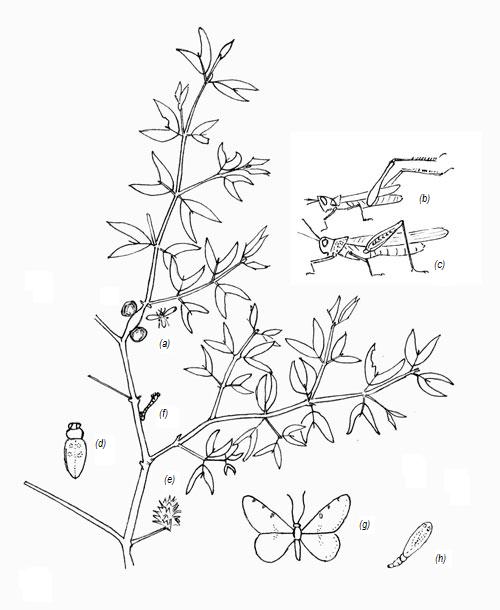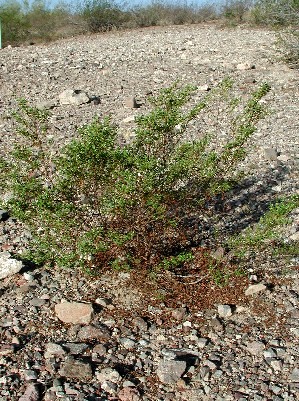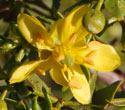Creosote Bush
Larrea tridentata

Drawn from live specimen growing near Lake Roosevelt, Arizona, USA on 7 Sept. 1992. A number of creosote bush insects are shown: (a) A pair of galls produced by larvae of Asphondylia midges and adult gnat, (b) a green-and-white grasshopper, Bootettix argentatus, (c) desert clicker, Ligurotettix coquilletti, (d) a buprestid beetle ca. Chrysobothris, (e) another gall produced by a different species of Asphondylia, (f) twig-mimicking caterpillar of a geometer, (g) the adult of caterpillar, Semiothisa pallidata and (h) pupal stage of the moth which normally hides beneath litter on the soil.

Photographed near Lookout Mountain, Phoenix Maricopa Co., Arizona. July 2002.
LEAVES: Small compound leaves are shiny, resinous, and dark green when
young but can remain on shrubs for extended periods turning almost brown but
still viable. The resin odor is at once acrid to deter plant eaters and yet
pungently pleasant. The whole desert takes on this heavenly aroma after a rain
shower signaling a return of life and verdancy.
RANGE: Abundant and drought-resistant shrub found in all the warm
deserts of southwestern United States and northwestern Mexico: Chihuahuan,
Sonoran and Mohave Deserts mostly below 1300 m elevation. Absent from
flood-prone areas along rivers.

FLOWERS: Yellow flowers with five petals appear generously in spring and
at almost any other time of year following periods of rain.
SHRUB: Medium to large sized shrubs. Often several seemingly distinct
shrubs will be growing together in a ring 6
to 20 m in diameter. This represents a clone of an original plant
that may have been growing continuously for thousands of years.
FRUIT: Spherical shizocarps with a halo of glistening white pubescence
have usually 5 sections each containing a single seed.
UNARMED. No thorns. Defense is provided by a suite of toxic/
anti-feeding chemicals including the phenolic compound
nordihydroguaiaretic acid.
Zygophyllaceae -- Caltrop Family
Sponsored Links:
One of the most amazing and beautiful insects that lives upon Creosote Bush is Creosote Bush Walkingstick (Diapheromera covilleae). Adults mature during the summer monsoon season and can most easily be found at night when their long, delicate antennae wave about almost constantly. They generally hang upside down.
Creosote Bush Walkingstick
More Info:
- Creosote Bush: Page 2, Page 3 and Page 4
- SEINET
- USDA Profile
- ITIS Taxonomic Report
- Google Images
- Google Scholar Literature Search
